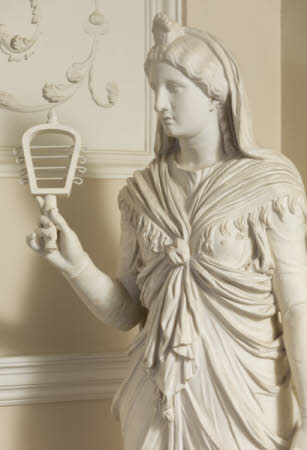The Capitoline Isis
workshop of Matthew Brettingham the Younger (1725 - 1803)
Category
Art / Sculpture
Date
circa 1758
Materials
Painted plaster
Measurements
1800 mm (Height)
Place of origin
London
Order this imageCollection
Kedleston Hall, Derbyshire
NT 108994
Summary
Painted plaster, the Capitoline Isis or a 'Priestess of Isis', possibly cast by Bartolomeo Mattevali, on behalf of Matthew Brettingham (1724-1803), cast c. 1758. A full-length plaster cast painted white of the goddess Isis or a priestess of Isis, after the Hadrianic marble in the Musei Capitolini, Rome (inv. no. Scu 744). The statue depicts a woman standing in contrapposto and wearing in a chiton and fringed mantle knotted between her breasts (the so-called knot of Isis). She is veiled and crowned with a headdress incorporating a stylized uraeus. In her proper left hand she holds a jug and in her proper right a sistrum (a type of sacred musical instrument). Isis was an Egyptian Goddess, the sister-wife of Orisis and mother of Horus; her worship was widespread throughtout the Greco-Roman world. The statue is mounted on a cylindrical base and pedestal.
Full description
Nathaniel Curzon (1726-1804) acquired this cast of Isis (or one of her priestesses) from Matthew Brettingham (1725-1803), an architect who primarily dealt in antiquities and casts for the British aristocracy. The cast is listed as 'Priestess of Isis' in Curzon's manuscript 'List of Statues that I have' (c.1760) and again in a list inscribed on the verso, under 'Saloon Statues' (MS, Kedleston Archive). The statue was initially installed in the Saloon (see 'Catalogue of the pictures, statues, &c. at Kedleston', 1758, Saloon, p. 9), but by c. 1788-89, when the Saloon was converted into a ballroom, it had been moved to the Great Staircase, where it stands today (see 'Catalogue', 1769, Great Staircase, p.22, annotated copy in the Getty Research Institute, annotations date to c. 1788-9.). No receipts have been found for this cast. During his seven-year stint in Rome (1747-54) Brettingham not only dealt in casts and antiquities - furnishing the Earl of Leicester, for example, with casts and marble statues for Holkham - but also commissioned actual moulds to be taken from famous Roman statues. The idea was that casts could then be made to order when he returned to London. The Capitoline Isis was one of twelve moulds of antique statues Brettingham commissioned, at considerable trouble and expense. In Brettingham's Rome Account Book, his ledger of statues dealt, casts made, bought and sold when he was in Italy, the records for 14 December 1753 show that a 'Mould of ye Vestal Virgin at ye Capital' was packed and shipped from Leghorn and that in 1754 further moulds 'of ye Vestal Virgin or Priestes of Isis' were produced (Kenworthy-Browne 1983, pp. 79, 99, 100). Unfortunately the moulds were not the success Brettingham hoped. Despite bringing back to London an Italian craftsman, Bartolomeo Mattevali. specifically for the job of casting from them, few actually sold. There are only two surviving casts of the Capitoline Isis, one of which is at Kedleston, the other at Holkham. Later versions at Stourhead and Croome Court (now Los Angeles County Museum of Art) were supplied by John Cheere. Alice Rylance-Watson March 2019
Provenance
Purchased by Nathaniel Curzon, 1st Baron Scarsdale (1726-1804), from Matthew Brettingham the Younger (1725-1803) c. 1758; identifiable in the 'Catalogue of the pictures, statues, &c. at Kedleston' of 1758 (Saloon, p. 9); and in the c. 1788-89 annotations of a 1769 Catalogue (Great Staircase, p. 22) see annotated copy in the Getty Research Institute, Los Angeles; and in the 1861 Catalogue (Great Staircase p. 25); purchased with part of the contents of Kedleston with the aid of the National Heritage Memorial Fund in 1987 when the house and park were given to the National Trust by Francis Curzon, 3rd Viscount Scarsdale (1924-2000).
Credit line
Kedleston Hall, The Scarsdale Collection (acquired with the help of the National Heritage Memorial Fund and transferred to the National Trust in 1987)
Makers and roles
workshop of Matthew Brettingham the Younger (1725 - 1803), dealer probably Bartolomeo Mattevali, caster
References
Kenworthy-Browne 1983: John Kenworthy-Browne, 'Matthew Brettingham's Rome Account Book 1747-1754', The Volume of the Walpole Society, vol.49 (1983), pp.37-132, pp. 79, 99, 100 Kenworthy-Browne 1993: John Kenworthy-Browne, ‘Designing around the statues. Matthew Brettingham’s casts at Kedleston’, Apollo, April 1993, pp.248-252 Young 1771 Arthur Young, The Farmer’s Tour through the East of England. Being The Register of a Journey through various Counties of this Kingdom, to enquire into the State of Agriculture, &c. 4 vols. London, 1771, vol.I, p.198




